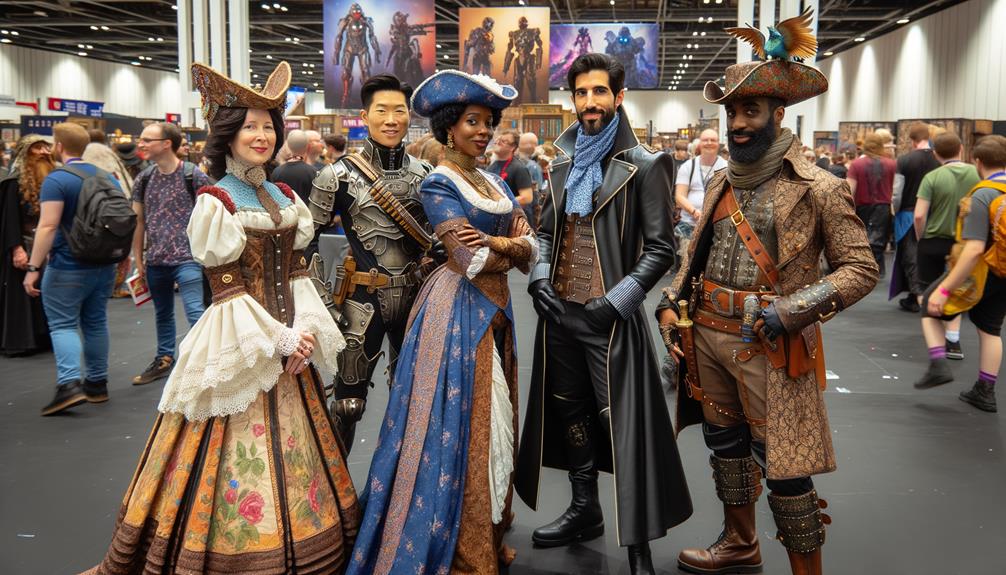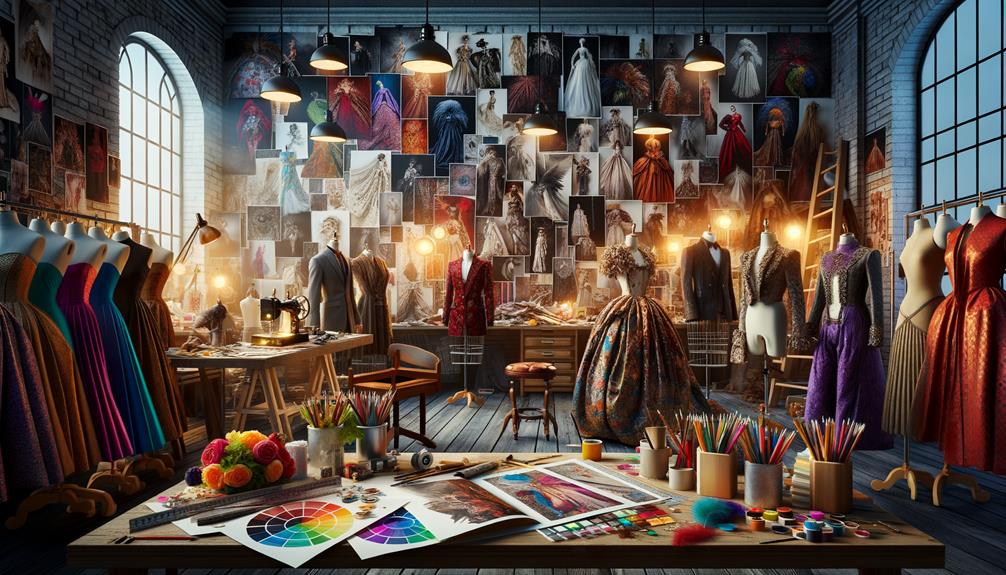In crafting costumes for fantastical worlds, I weave stories with fabric and thread. Each garment reflects the character's journey, echoing their past and aspirations. Silk flows like whispers of enchantment, while leather roots them in ancient tales. Colors burst with life or ground with nature's hues. Symbols and motifs convey tales of noble lineage or common struggle, guided by the world's culture and climate. Through every stitch and dye, characters come to life, and worlds unfold before our eyes. There's more to the fabric than meets the eye, each detail a secret waiting to be discovered.
Character Background and Story
In the heart of costume design, a character's backstory and journey shape their visual identity. It's like painting with threads, where each stitch whispers of their past and each fold glimpses their soul. I find myself delving into their personality, uncovering the raw essence that propels their actions and motivations. This intimate exploration is where the magic happens, where the character's costume is born as an extension of their narrative.
Every piece they wear tells a story – the intricate embroidery symbolizing their heritage, the wear and tear echoing their struggles and triumphs. I must balance aesthetics with function, ensuring their attire serves their journey and goals within the fantastical world. The choices become a dance between fabric and fate, each detail meticulously chosen to reflect their inner landscape.
Collaborating with the writing and world-building teams, I weave their tales into tangible form, aligning every motif and symbol with the broader narrative. It's a delicate art, crafting a visual identity that not only adorns but amplifies their story, making them unforgettable.
Reflecting the World's Culture
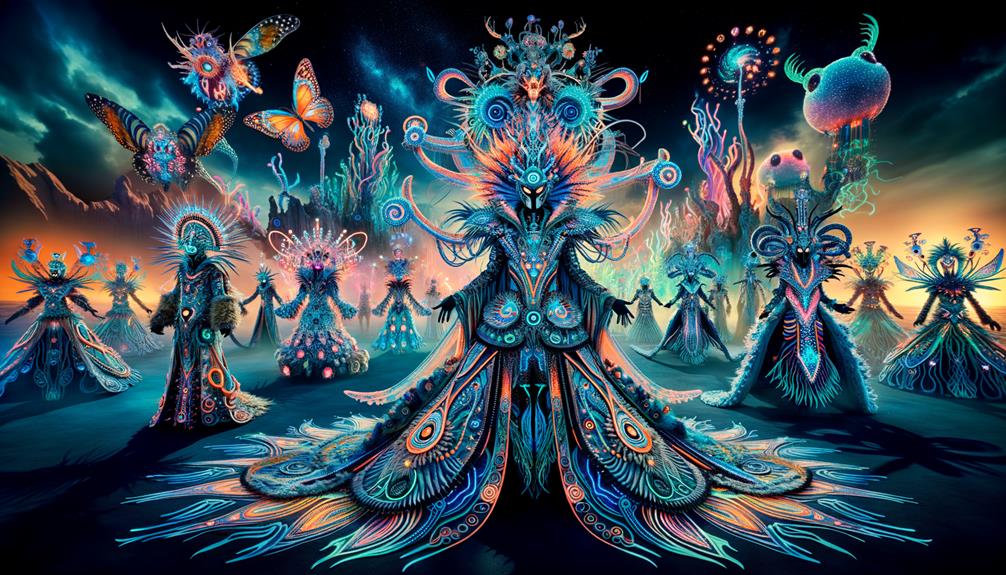
Amid the vivid tapestry of a fantastical world, costumes become silent narrators, echoing the cultures, hierarchies, and environments that breathe life into the domain. As a costume designer, I've learned that the garments we create must carry the essence of real life, drawing from the rich, diverse fashion traditions around the globe. Our task is to craft outfits that don't just clothe characters but tell stories of their origins, struggles, and triumphs.
Reflecting the world's culture through costume design involves a delicate balance between imagination and authenticity. We must infuse our creations with elements that resonate with the audience on a subconscious level:
- Patterns and symbols that evoke specific traditions and histories.
- Attire that differentiates the nobility from the common folk, reflecting societal structures.
- Clothing that mirrors the climate and terrain of each region, demonstrating environmental adaptation.
- Outfits that showcase the world's unique advancements or mystical elements, incorporating technological and magical influences.
In this endeavor, we must remain vigilant against cultural appropriation, ensuring that our inspirations honor their sources. The best designs seamlessly blend the fantastical with the familiar, crafting a world that's both innovative and deeply, undeniably human.
Material and Color Choices
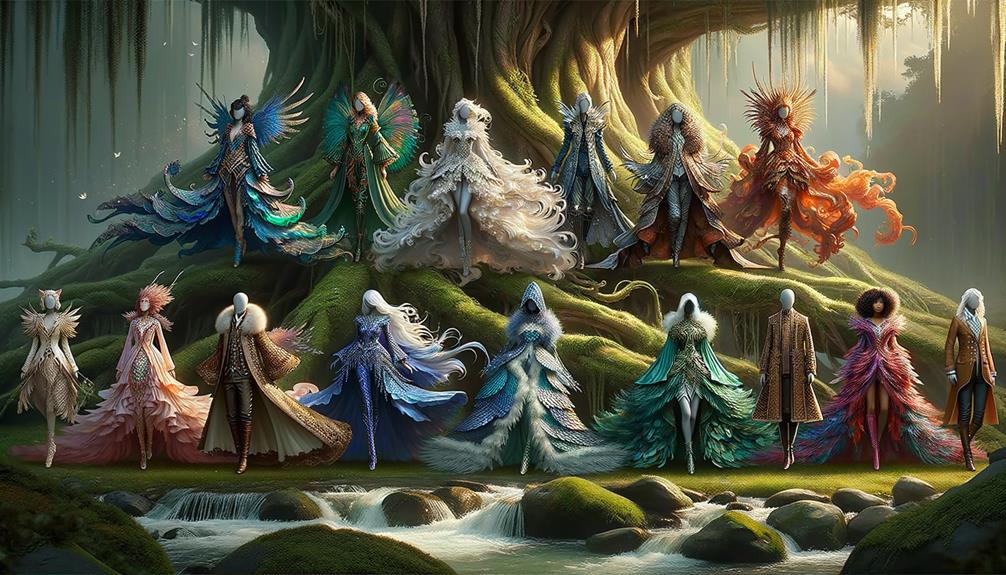
When I think about materials and colors for fantastical costumes, it's like creating a visual symphony. Lightweight yet sturdy fabrics have their own stories to tell, while nature-inspired hues breathe life into mythical realms. Metallic sheens and unexpected color combinations dance with light and shadow, crafting a world that feels both ancient and enchanted.
Fabrics whisper of their own histories, while colors inspired by the natural world bring these fantastical domains to life. Metallic accents and unusual color pairings create a captivating play of illumination and shadow, constructing a realm that feels both timeless and enchanted.
Fabric Selection Techniques
The beauty of fabric goes beyond its texture. It has the power to evoke emotions and transport us to extraordinary realms. In costume design, selecting the right fabric is akin to choosing the ideal words for a poem. Each material whispers its own story, and every color sings a distinct note in the symphony of a fantastical world. When exploring fabric selection, I let my senses guide me, seeking materials that can breathe life into my creations.
Silk's fluidity mirrors the ethereal, capturing the essence of dreams and delicate fantasies. Leather, rugged and raw, speaks of strength and ancient tales, grounding the fantastical in a sense of reality. Velvet, luxurious and deep, holds secrets within its folds, making it perfect for characters of nobility or mystery. Linen, earthy and honest, connects the wearer to nature, ideal for pastoral or elemental beings.
My choices hinge not just on aesthetics, but on the fabric's ability to convey emotion and narrative. I strive to innovate, pushing the boundaries of traditional costume design, crafting garments that aren't just seen, but felt. It's a journey, a dance between texture and imagination.
Optimal Color Palette
As a costume designer, I'm constantly drawn to vibrant, jewel-toned colors that capture the essence of the otherworldly. Think emerald greens, sapphire blues, and ruby reds – each shade a portal to a different domain, saturated with possibilities.
Incorporating metallic accents like gold, silver, and bronze can evoke a sense of grandeur and enchantment. These elements shimmer with a magic that feels almost tangible, as if the characters themselves possess hidden powers. Iridescent or color-shifting fabrics add another layer of mysticism, their hues changing with each movement, creating an ever-evolving tapestry of color.
Yet, even in a fantasy world, grounding elements are crucial. Earth tones and natural hues remind us of the organic roots of these fantastical beings. They offer a balance, a connection to the natural world amidst the grandeur.
Avoiding muted or desaturated colors is key; bold, saturated palettes command attention and convey the grandeur intrinsic to the fantastical domain. Each color choice is deliberate, breathing soul into the fabric of imagination.
Practicality and Functionality
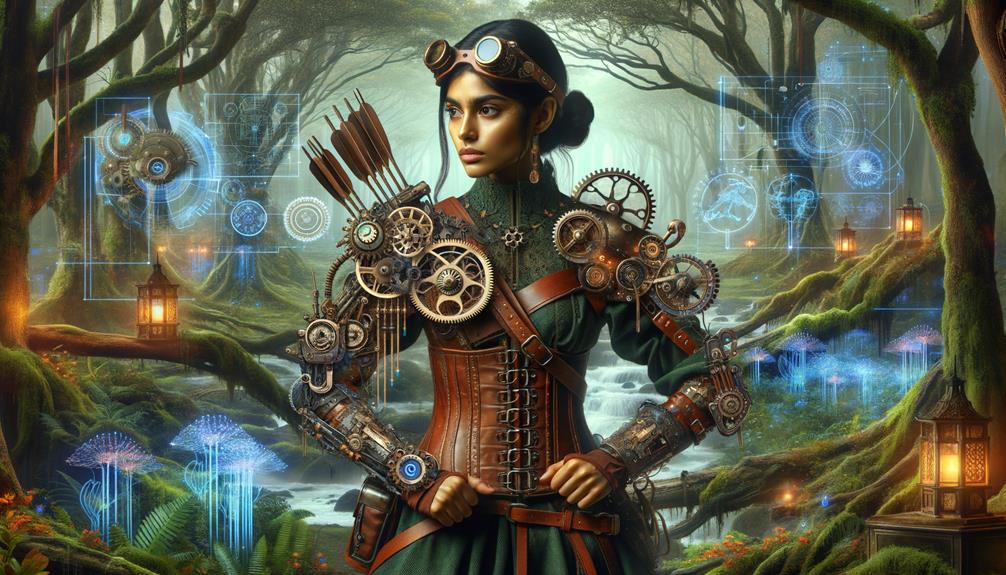
Often, the real magic of fantastical worlds lies in the practical and functional design of their costumes. As I create these garments, I need to balance imagination with usefulness. It's a delicate process that requires new skills and constant adaptation. Every stitch and fabric choice must serve a purpose beyond just looking good.
To achieve this, I consider:
- Durability: The costumes must withstand the demands of filming, from intense action scenes to long hours under hot lights.
- Mobility: Actors need to be able to move freely, without being restricted by cumbersome attire.
- Comfort: Lightweight, breathable fabrics are essential to prevent fatigue and keep the actor comfortable throughout the day.
- Adjustability: Garments should be easily altered to fit the actor's changing physique over the course of production.
These elements aren't just technicalities – they're the foundation of believable, immersive worlds. Every choice I make, whether it's using water-resistant materials or ensuring fire safety, brings these otherworldly characters to life. It's this commitment to practicality and functionality that transforms fantasy from fiction into a tangible experience.
Social Status and Style
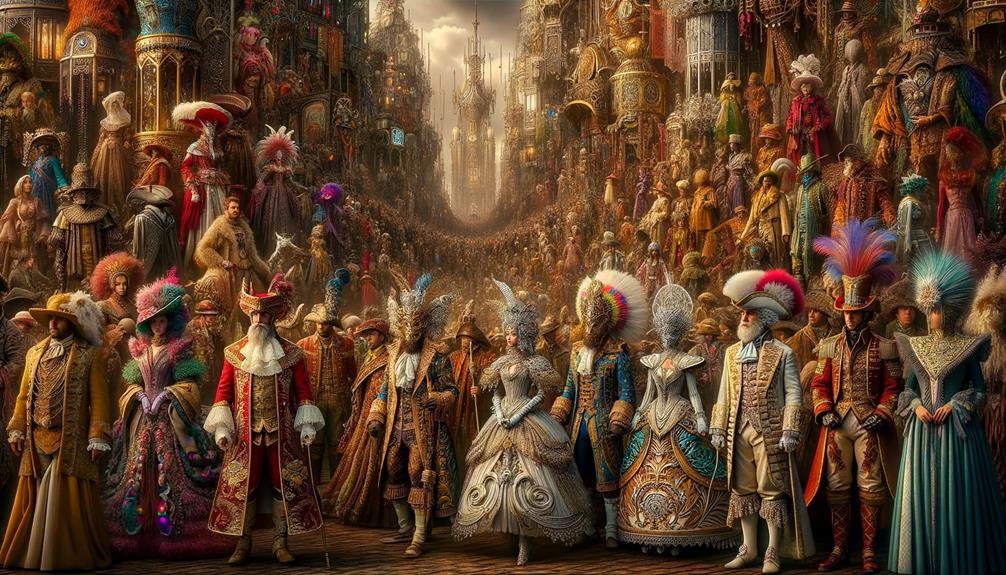
In the fantastical world, what we wear is more than just fabric and thread – it's a silent declaration of our status and influence. The elite don their opulent garments, draping themselves in shimmering silks and rich velvets, their grand capes and ornate headpieces hinting at their power and privilege.
The very silhouettes of these outfits speak volumes. Noble rulers sport meticulously tailored, regal ensembles, while humble peasants don simpler, more practical attire. Rare materials and intricate embroidery set the upper classes apart, their costumes woven with threads that suggest luxury and exclusivity.
Colour also plays a pivotal role in this social hierarchy. Bold, vibrant hues like royal purple or deep crimson are the dominion of the aristocracy, while muted earth tones cloak the lower classes. Accessories become symbols too – jeweled sashes, heraldic insignia, and elaborate jewelry further delineate one's place in the social strata.
In this realm of imagination, every stitch and embellishment is a brushstroke on the canvas of societal structure, painting a vivid picture of the world's internal hierarchies.
Consistency and Immersion
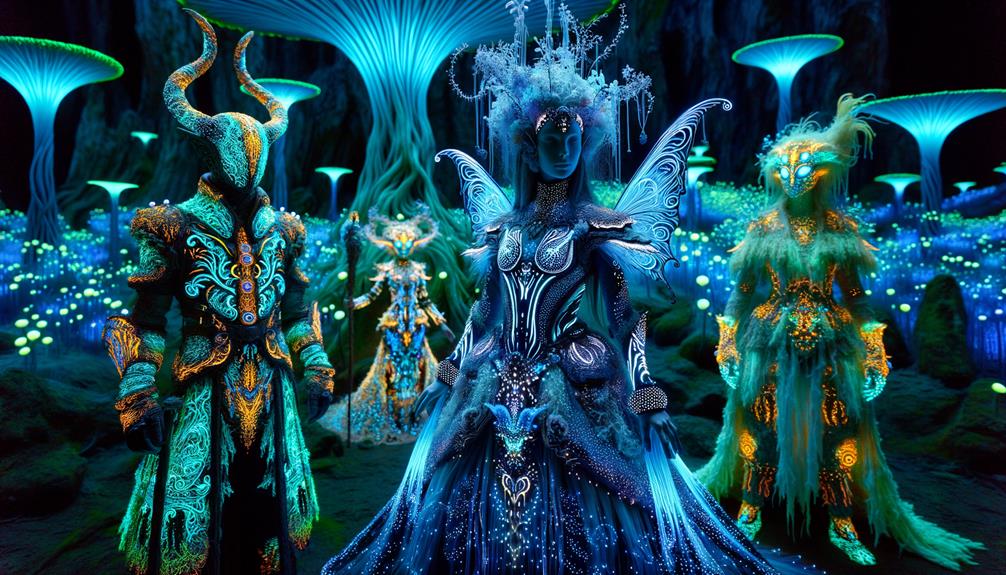
When I consider consistency and immersion, I envision a vibrant tapestry woven with harmonious colors and authentic materials that breathe life into fantasy worlds. Each character's attire must align seamlessly with their journey, ensuring continuity and depth. It's in these intricate threads that an entire realm is stitched together, feeling believable and whole.
The clothing and accessories of the characters are crucial for creating a cohesive and compelling narrative. They shouldn't feel out of place or like an afterthought. Rather, they should enhance the storytelling, making the world and its inhabitants more tangible and relatable for the audience.
Consistency in costume design helps establish a sense of place and time, while also revealing insights about a character's personality, background, and role within the larger narrative. When done well, these sartorial details can transport the viewer, fostering a deeper level of immersion and investment in the fictional realm.
Cohesive Color Schemes
In a fantastical world, a cohesive color scheme weaves together the threads of imagination, creating a seamless domain where each hue tells its own story. The magic lies in establishing a color palette that brings life to the characters and settings, evoking emotions and guiding the viewer's journey through the narrative.
By using a limited color scheme, accented with carefully chosen hues, we ensure a consistent aesthetic that avoids visual chaos. This palette coordination extends beyond costumes, blending harmoniously with set pieces and lighting to enhance the immersive experience. Principles of color theory become our allies, whether through the vibrant clash of complementary colors or the serene unity of a monochromatic scheme. Each choice is deliberate, each shade a stroke in the grand painting of our fantastical world.
Colors can conjure warmth, danger, or mystery, evoking specific moods. Heroes, villains, and mystics each have a visual identity defined by color. Symbolic and cultural meanings imbue the story with richer layers, enhancing narrative depth. A unified scheme ties the world together, making it believable and creating visual harmony.
In this intricate dance of colors, we craft not just costumes but an entire universe of wonder.
Material Authenticity
The magic of tangible materials is profound. When we create costumes, the authenticity of natural fibers, leathers, and metals isn't just about looks – it's about immersion. The tactile quality of these materials brings the characters and environments to life, making the viewer feel they could reach out and touch another world.
Blending modern and historical materials can lend a timeless quality, bridging epochs to amplify the fantastical. Dyes, textures, and aging techniques are carefully selected to reflect the world's unique conditions, ensuring consistency and cohesion in the designs. Even unseen details contribute to the overall realism and craftsmanship.
| Material Type | Example |
|---|---|
| Natural Fibers | Linen, Cotton |
| Leathers | Softened Hide, Suede |
| Metals | Bronze, Steel |
| Modern Blends | Synthetic Fabrics with Historical Look |
Character Alignment
The careful design of a character's costume is essential to immersing the audience in a fantastical world. Each detail – from the stitching to the fabric choice – speaks to the character's backstory, motivations, and journey. As a costume designer, I strive to ensure that the attire is a true extension of the character's soul.
To bring these imaginary realms to life, I focus on several key elements:
- Character's Journey: The costumes evolve alongside the character, reflecting the shifts in their story.
- Color Palettes: Consistent color schemes create a cohesive visual language, unifying the world.
- Material Choices: Textures and fabrics that align with the internal logic of the world, adding authenticity.
- Supporting Characters: Attention to detail for every character, ensuring depth and believability.
These visual cues are not mere decoration, but silent narrators that guide the audience through the fantastical. By ensuring consistency in character alignment, we can craft worlds that linger in the imagination long after the credits roll.
Frequently Asked Questions
What Is Fantastical Costume Design?
Fantastical costume design is the art of bringing imagination to life through fabric and form. It's a delicate balance of weaving history and creativity, crafting garments that breathe life into characters and transport us to realms beyond our own. Designers in this field masterfully blend the essence of a story with their boundless creativity, captivating audiences and immersing them in captivating worlds.
What Are the 4 Types of Costumes?
The four main types of costumes are theatrical, historical, fantasy, and ceremonial. Each one tells a story, brings characters to life, and reflects our collective imagination. They connect us to different times, dreams, and aspects of identity.
Theatrical costumes are designed to suit the needs of the stage, whether it's a grand opera or an intimate play. They help actors convey emotions and establish their characters. Historical costumes accurately recreate the fashions of a specific era, transporting the wearer and the audience to a different time and place. Fantasy costumes allow people to become something entirely new – from mythical creatures to futuristic heroes. Ceremonial costumes are often steeped in tradition, marking important cultural or religious events.
Regardless of the type, costumes have the power to captivate, inspire, and connect us to the human experience. They are vital tools for storytelling and self-expression.
How Do You Get Costumes in Tower of Fantasy?
In Tower of Fantasy, there are a few ways to get your hands on costumes. You can find them in the game's events – these limited-time events sometimes offer exclusive outfits as rewards. The gacha system, where you pull random items, is another source of rare and fancy costumes. And of course, the in-game store sells a selection of stylish outfits you can purchase directly. It's like chasing after a butterfly – the thrill of discovering and equipping these unique looks adds an extra layer of personality and power to your character.
What Three Categories Do Costume Designers Fall Into?
Costume designers can be categorized into three main groups. First, there are those who focus on conceptualizing the characters, capturing their essence and personality through the garments. Then, there are designers who specialize in creating specific attire, such as intricate battle armor or ceremonial robes. Finally, there are the practical, creative minds who bring the designs to life, translating sketches into tangible, visually stunning costumes.
Each of these roles is crucial in weaving the tapestry of fantastical, innovative storytelling through costume design. The character conceptualizers establish the foundation, the specialized designers add depth and authenticity, and the practical creatives bring it all together seamlessly on screen.
Conclusion
Creating costumes for fantastical worlds is like weaving dreams into fabric. Each stitch tells a story, and each color whispers secrets of the world it belongs to. These designs reflect culture, status, and practicality, bringing characters to life in an unforgettable way. It's a delicate balance between imagination and reality, completely immersing us in the story. Costume design isn't just about clothing characters; it's about giving them a soul. And to me, that's the true magic of it.



